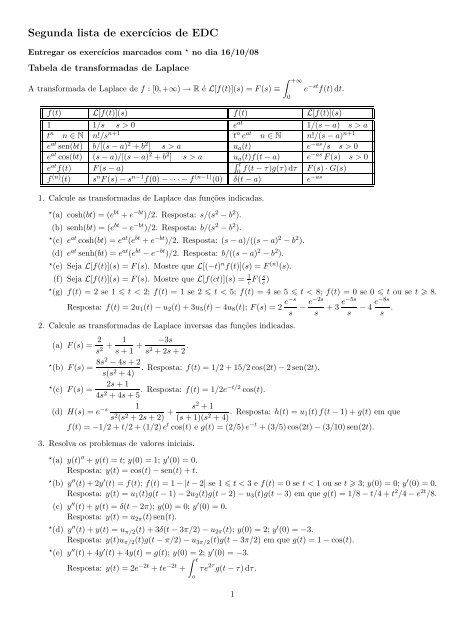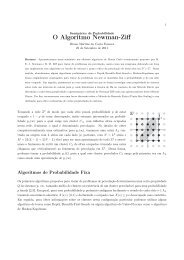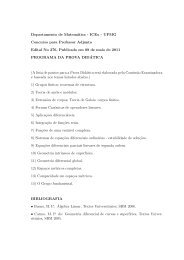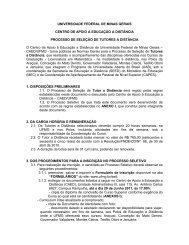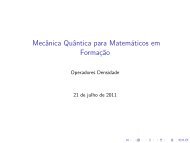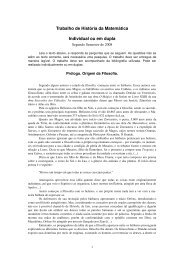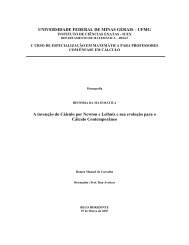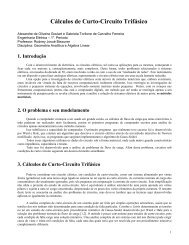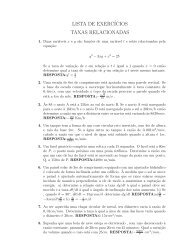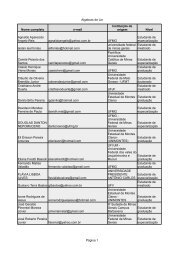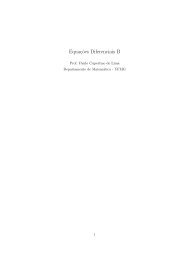Segunda lista de exerc´ıcios de EDC
Segunda lista de exerc´ıcios de EDC
Segunda lista de exerc´ıcios de EDC
Create successful ePaper yourself
Turn your PDF publications into a flip-book with our unique Google optimized e-Paper software.
<strong>Segunda</strong> <strong>lista</strong> <strong>de</strong> exercícios <strong>de</strong> <strong>EDC</strong>Entregar os exercícios marcados com ⋆ no dia 16/10/08Tabela <strong>de</strong> transformadas <strong>de</strong> LaplaceA transformada <strong>de</strong> Laplace <strong>de</strong> f : [0,+∞) → R é L[f(t)](s) = F(s) ≡∫ +∞0e −st f(t)dt.f(t) L[f(t)](s) f(t) L[f(t)](s)1 1/s s > 0 e at 1/(s − a) s > at n n ∈ N n!/s n+1 t n e at n ∈ N n!/(s − a) n+1e at sen(bt) b/[(s − a) 2 + b 2 ] s > a u a (t) e −as /s s > 0e at cos(bt) (s − a)/[(s − a) 2 + b 2 ] s > a u a (t)f(t − a) e −as F(s) s > 0e at ∫ tf(t) F(s − a)0f(t − τ)g(τ)dτ F(s) · G(s)f (n) (t) s n F(s) − s n−1 f(0) − · · · − f (n−1) (0) δ(t − a) e −as1. Calcule as transformadas <strong>de</strong> Laplace das funções indicadas.⋆ (a) cosh(bt) = (e bt + e −bt )/2. Resposta: s/(s 2 − b 2 ).(b) senh(bt) = (e bt − e −bt )/2. Resposta: b/(s 2 − b 2 ).⋆ (c) e at cosh(bt) = e at (e bt + e −bt )/2. Resposta: (s − a)/((s − a) 2 − b 2 ).(d) e at senh(bt) = e at (e bt − e −bt )/2. Resposta: b/((s − a) 2 − b 2 ).⋆ (e) Seja L[f(t)](s) = F(s). Mostre que L[(−t) n f(t)](s) = F (n) (s).(f) Seja L[f(t)](s) = F(s). Mostre que L[f(ct)](s) = 1 c F(s c )⋆ (g) f(t) = 2 se 1 t < 2; f(t) = 1 se 2 t < 5; f(t) = 4 se 5 t < 8; f(t) = 0 se 0 t ou se t 8.Resposta: f(t) = 2u 1 (t) − u 2 (t) + 3u 5 (t) − 4u 8 (t); F(s) = 2 e−ss − e−2s+ 3 e−5s− 4 e−8ss s s .2. Calcule as transformadas <strong>de</strong> Laplace inversas das funções indicadas.(a) F(s) = 2 s 2 + 1s + 1 + −3ss 2 + 2s + 2 .⋆ (b) F(s) = 8s2 − 4s + 2s(s 2 . Resposta: f(t) = 1/2 + 15/2cos(2t) − 2sen(2t).+ 4)⋆ 2s + 1(c) F(s) =4s 2 + 4s + 5 . Resposta: f(t) = 1/2e−t/2 cos(t).(d) H(s) = e −s 1s 2 (s 2 + 2s + 2) + s 2 + 1(s + 1)(s 2 + 4) . Resposta: h(t) = u 1(t)f(t − 1) + g(t) em quef(t) = −1/2 + t/2 + (1/2)e t cos(t) e g(t) = (2/5)e −t + (3/5)cos(2t) − (3/10)sen(2t).3. Resolva os problemas <strong>de</strong> valores iniciais.⋆ (a) y(t) ′′ + y(t) = t; y(0) = 1; y ′ (0) = 0.Resposta: y(t) = cos(t) − sen(t) + t.⋆ (b) y ′′ (t) + 2y ′ (t) = f(t); f(t) = 1 − |t − 2| se 1 t < 3 e f(t) = 0 se t < 1 ou se t 3; y(0) = 0; y ′ (0) = 0.Resposta: y(t) = u 1 (t)g(t − 1) − 2u 2 (t)g(t − 2) − u 3 (t)g(t − 3) em que g(t) = 1/8 − t/4 + t 2 /4 − e 2t /8.(c) y ′′ (t) + y(t) = δ(t − 2π); y(0) = 0; y ′ (0) = 0.Resposta: y(t) = u 2π (t)sen(t).⋆ (d) y ′′ (t) + y(t) = u π/2 (t) + 3δ(t − 3π/2) − u 2π (t); y(0) = 2; y ′ (0) = −3.Resposta: y(t)u π/2 (t)g(t − π/2) − u 3π/2 (t)g(t − 3π/2) em que g(t) = 1 − cos(t).⋆ (e) y ′′ (t) + 4y ′ (t) + 4y(t) = g(t); y(0) = 2; y ′ (0) = −3.Resposta: y(t) = 2e −2t + te −2t +∫ toτe 2τ g(t − τ)dτ.1
4. Transformada <strong>de</strong> Laplace <strong>de</strong> funções periódicas. Seja f uma função periódica <strong>de</strong> período T > 0no semi-eixo positivo, isto é, f(t + T) = f(t) para todo t 0. A transformada <strong>de</strong> Laplace <strong>de</strong> f é dada pela∫1 Tfórmula L[f(t)](s) =1 − e −Ts e −st f(t)dt.0(a) Calcule a transformada <strong>de</strong> Laplace da função f periódica <strong>de</strong> período T = 2 <strong>de</strong>finida por f(t) = 1 se0 t < 1 e f(t) = 0 se 1 t < 2.Resposta: F(s) = 1/[s(1 − e −2s )].(b) Calcule a transformada <strong>de</strong> Laplace da função onda quadrada periódica <strong>de</strong>finida por f(t) = k se 0 t < ae f(t) = −k se a t < 2a e <strong>de</strong> período T = 2a.Resposta: F(s) = k [ 1 − e−as]s 1 + e −as = k s tanh(as/2).(c) Calcule a transformada <strong>de</strong> Laplace da função onda triangular periódica <strong>de</strong>finida por f(t) = a − |t − a|se 0 t 2a e <strong>de</strong> período T = 2a.Sugestão. Verifique que a função dada é a integral <strong>de</strong> função <strong>de</strong> onda quadrada periódica do itemanterior para k = 1 e use a tabela <strong>de</strong> transformadas. Resposta: F(s) = 1 s 2 tanh(as/2).(d) Calcule a transformada <strong>de</strong> Laplace do retificador <strong>de</strong> meia onda, <strong>de</strong>finido por f(t) = sen(ωt) se 0 t


